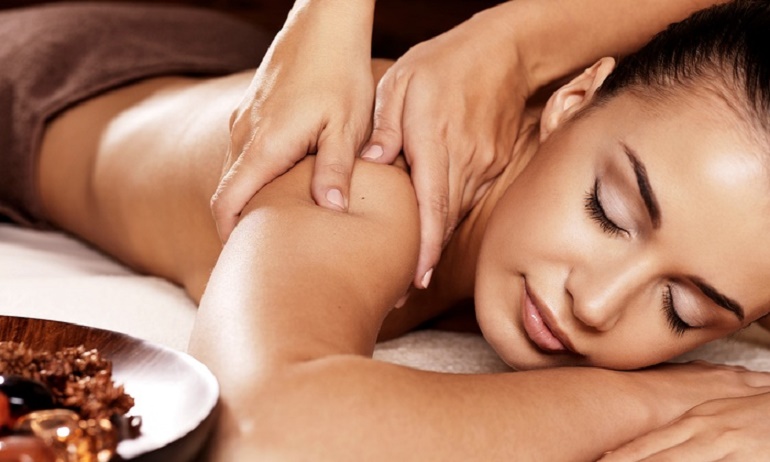
Massage is the practice of applying structured pressure, tension, motion or vibration -- manually-- to the soft tissues of the body, including muscles, connective tissue, tendons, ligaments, joints and lymphatic vessels, to achieve a beneficial response. A form of therapy, massage can be applied to parts of the body or successively to the whole body, to heal injury, relieve psychological stress, manage pain, and improve circulation. Where massage is used for its physical and psychological benefits, it may be termed "therapeutic massage therapy" or manipulative therapy.
GENERAL EFFECTS OF THERAEUTIC MASSAGE
Skeletal System
Muscular and tendon tension is reduced, the flow of nutrients to bones is increased and the elimination of waste matter is promoted. Tension is reduced from certain joints which increases flexibility.
Muscular System
When muscles become overloaded with toxic waste products such as uric and lactic acids, fatigue and eventually pain occurs. This reaction is common after injury, over-exertion and performance. Massage is also used to maintain the stretch, mobility and tone of the muscles and muscle fibers. Massage is also used to maintain the stretch, mobility and tone of the muscles, keeping the body young and pliable.
Nervous System
Sensitivity in the nerve endings is heightened: allowing the individual to "float off" and let go that nervous tension. Massage on the back relaxes the spinal nerves which govern the body.
Vascular System
Massage reduces the strain of the heart and increases the return of blood through the veins to the heart; thus allowing new blood to be pumped through arteries and capillaries. Lymphatic fluid is moved more efficiently through the body and the drainage of toxins is improved- which assist the body in fighting off toxins. Edema is reduced as fluid is moved and brought into nutritional absorption, because fresh nutrients are allowed to enter the system at a faster rate. Metabolism and organ function improves. In some case, blood pressure can be effectively reduced. Anemia may be alleviated through massage as the red blood cells become unstuck from the walls of vessels.
Respiratory system
The lungs benefit from massage as mucus and secretions are dislodged, dispersed and eliminated The blood becomes oxygenated from the increase in circulation. Together with the oils breathing patterns are improved.
Digestive System
Massage stimulates the action of peristalsis, which moves material through the intestines and bowels. a spastic colon is relieved. Excretion of inorganic minerals and salts via the kidneys is facilitated and urine flow increased; this helps to clean the blood and tone the system.>
Lymphatic system
The flow of lymph is increased with massage. The function of the lymph is to supply the parts of the body not reached by blood, carry nourishment from the blood to the body cells and remove waste material from the body cells, carry on a constant interchange with the blood and assist in eliminating poisons with the help of the lymphocytes.
Polarity Balancing
When the vital energy current is not flowing correctly, it can cause illness and disease in the body, it is the science of balancing the bodies own life currents. Polarity therapy helps to unblock these currents allowing the energy force to flow smoothly again, this is an essential part at completion of the massage, and helps to create a harmonious energy flow between me and my client.
Health Benefits of Massage
The following are the key effects of massage:
Massage Reduces Muscle Tension.
Massage affects the muscles throughout the body. Massage affects the muscles and other soft tissues throughout the body. It loosens contracted, shortened, hardened muscles. Massage can stimulate weak, flaccid muscles. Chronic muscle tension reduces the circulation of the blood and movement of lymph in an area.
Massage Improves Blood Circulation. The oxygen capacity of the blood can increase 10-15% after massage. By indirectly or directly stimulating nerves that supply internal organs, blood vessels of these organs dilate and allow greater blood supply to them.
Massage Induces Better Lymph Movement. Lymph is a milky white fluid that drains impurities and waste away from the tissue cells. A component of these wastes is toxins which are the by-products of metabolism. So, it is a vital to our health. Muscular contraction has a pumping effect that moves lymph. Massage and exercise help to move lymph.
Massage Results In Increased Mobility and Range of Motion of Joints. Massage provides a gentle stretching action to both the muscles and connective tissues that surround and support the muscles and many other parts of the body, which helps keep these tissues elastic.
Massage Stimulates or Soothes Nervous System. Massage balances the nervous system by soothing or stimulating it, depending on which effect is needed by the individual at the time of the massage.
Massage Enhances Skin Condition. Massage enhances the skin condition by improving the function of the sebaceous and sweat glands, which keep the skin lubricated, clean, and cool.
Massage Results in Better Digestion and Intestinal Function. Massage increases the body's secretions and excretions. It increases the production of gastric juices, saliva, and urine. There is also an increased excretion of nitrogen, inorganic phosphorus, and salt. As a result, the metabolic rate increases.
Massage Relieves of Acute and Chronic pain. Massage can promote recovery from the fatigue and from minor aches and pains